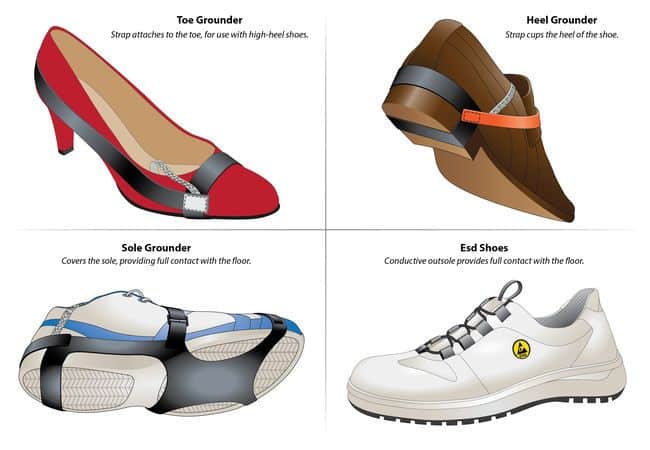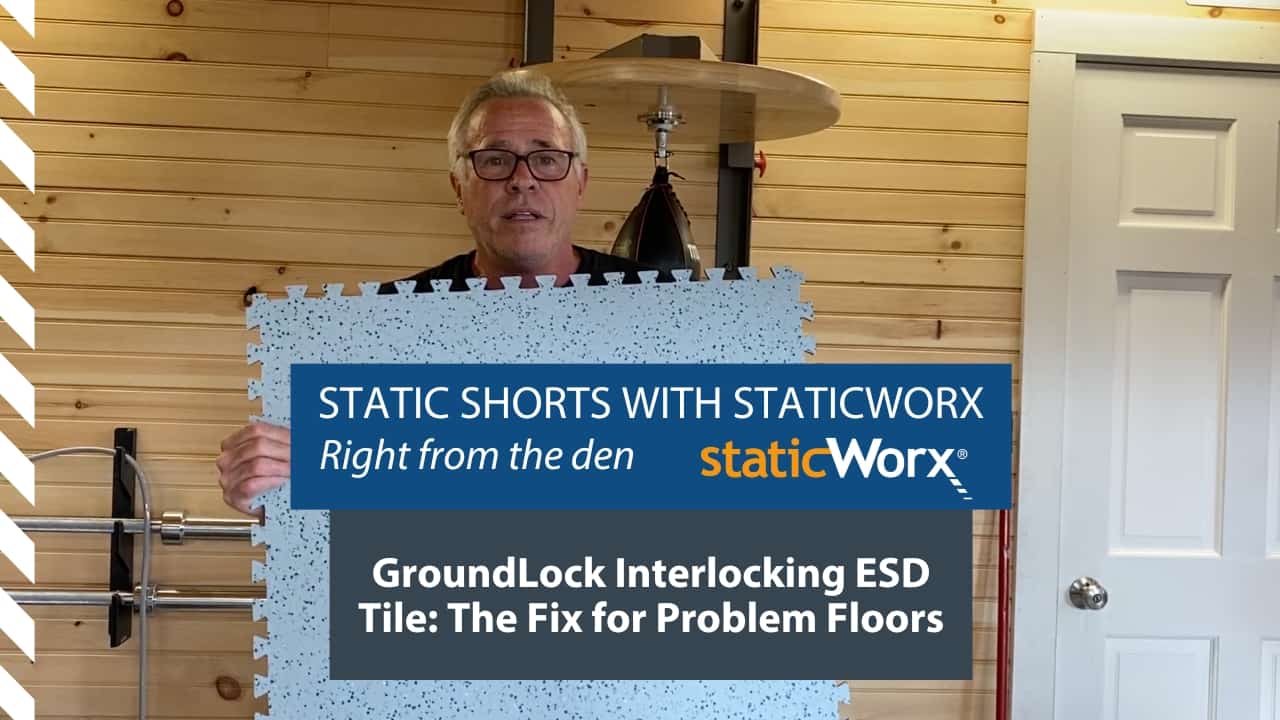
Flooring for Electronics Manufacturing & Handling Applications
Electronics industry flooring applications—including electronics manufacturing facilities, microelectronics fabrication, circuit board assembly, box build, electronics test and repair, cleanrooms, labs and R&D facilities—have more stringent static-control requirements than do most other applications.
Electronic equipment with highly sensitive microcircuits is particularly susceptible to damage caused by the sudden spike in electrical current that results from random static discharge. The protocols set by the ESD Association, in their standard ANSI/ESD S20.20, were created for these spaces.
Choosing the Right ESD Floor
To prevent random static events, ESD floors—also known as antistatic floors or static-control floors—must perform two equally important functions:
- Provide personnel and equipment with a verifiable path to ground of less than or equal to 1 billion ohms (≤ 1.0 x 10E9);
- Prevent static charges in excess of 100 volts (< .1 kV) from accumulating as people walk (called walking body voltage).
ESD Standards
Electronics manufacturing and handling facilities adhere to ANSI/ESD S20.20. Note: S20.20 requires that all personnel within an ESD Protected Area (EPA)* use ESD-protective footwear – i.e., heel straps, toe straps, sole straps or ESD shoes. ESD footwear creates an electrical bond with conductive elements in ESD flooring, allowing for wider choice in ESD flooring materials.

EPA: “a defined location with the necessary materials, tools and equipment capable of controlling static electricity to a level that minimizes damage to ESD-susceptible items.”
ANSI/ESD S20.20
ESD Association Standard for the Development of an Electrostatic Discharge Control Program for Protection of Electrical and Electronic Parts, Assemblies and Equipment (Excluding Electrically Initiated Explosive Devices). This standard provides administrative and technical requirements for establishing, implementing and maintaining an ESD Control Program.
Electrical resistance of a flooring system (ANSI/ESD STM 7.1)
Point to Point: < 1.0 x 10E9 ohms
Point to Groundable Point: < 1.0 x 10E9 ohms
Resistance of Footwear/Flooring System (ANSI/ESD STM 97.1)
< 1.0 x 10E9 ohms
Floor Materials and Footwear Maximum Voltage in Combination with a Person (ANSI/ESD STM 97.2)
< 100 volts Peak
For fundamentals on electrostatic discharge and further information on ESD standards, see: Fundamentals of Electrostatic Discharge.
CLASS-0 ELECTRONICS
Class-0 Electronic Devices
Class 0: Although standards organizations have not fully defined the term ESD Class 0 for manufacturing programs, the classification is widely used within the electronics industry to represent ultra-sensitive devices. While most companies are acutely aware of the hazards of ESD (electrostatic discharge), few are aware of best practices for preventing failures of today’s extremely sensitive devices often referred to as Class 0.
Floors for Class 0 applications must satisfy electrical resistance requirements in ANSI/ESD S20.20 and generate less than 20 volts on a person wearing protective footwear in combination with ESD flooring.
Point to Point, Point to Groundable Point, and Footwear/Flooring System: < 1.0 x 10E9
Charge Generation: < 20 volts
IEC 61340-5-1*
From IECEE.ORG: Electrostatics – Part 5-1: Protection of electronic devices from electrostatic phenomena – General requirements.
The purpose of this standard is to provide the administrative and technical requirements for establishing, implementing and maintaining an ESD control program …This [updated] version of IEC 61340-5-1 has been aligned with other major ESD control program standards used throughout the world.
* IEC 61340-5-1 is the European equivalent to ANSI/ESD S20.20
Applications
Applications include any facility that manufactures, packages, tests, repairs or handles high-speed electronic components.
- Computer and PCB Assembly
- Surface Mount Technology (SMT)
- Configuration and ESDS Device Handling
- Automated Assembly Areas
- Electronic Assembly Areas
- Automated Guided Vehicle Areas
- Surface Mount and Wave Solder Areas
- BGA Rework
- Box Build
- Wafer Fab
- Cleanrooms
- Labs
- Repair
- Computer and PCB Assembly
- Surface Mount Technology (SMT)
- Configuration and ESDS Device Handling
- Automated Assembly Areas
- Electronic Assembly Areas
- Automated Guided Vehicle Areas

- Surface Mount and Wave Solder Areas
- BGA Rework
- Box Build
- Wafer Fab
- Cleanrooms
- Labs
- Repair
Ideal, Best Practice
- Overview
- Rubber tile & sheet flooring
- Interlocking tiles
- ESD carpet tile
- Conductive vinyl tile
- Generation 3 ESD coatings & epoxy
For electronics manufacturing and handling facilities, ESD standard S20.20 requires the use of ESD-protective footwear. Acceptable ESD footwear includes conductive heel straps, toe straps, sole straps and ESD shoes.

The conductive elements in ESD-protective footwear bond with the conductive elements in the floor, creating a reliable ground connection and protecting the wearer against potential shocks on an overly conductive floor. This allows for a wider range of acceptable flooring choices.
Please note: Since this is all about 20.20 and electronics manufacturing, it should be assumed that ESD footwear will be used.
Recommended Flooring Options
- Rubber tile & sheet flooring
- ESD carpet
- GroundLock interlocking or lay-flat tile
- Conductive vinyl
- Some static-dissipative vinyl – if static generation is under 100 volts
- Generation 3 ESD epoxy coatings
NOT Recommended
Non-compliant static-control flooring
- Generation 2 epoxies
- Static-dissipative vinyl measuring above 100 volts per STM97.2
- Vinyl floors with sparse distribution of conductive granules
The electrical performance of these floors is unreliable.
Caution before using
- Any flooring product that relies on antistatic polish or wax for static-control properties
- Static-dissipative vinyl tile or sheet flooring that requires ESD polish or wax to retain static-dissipative properties
Temporary finishes wear off. To ensure compliance with ANSI S20.20, the floor must be tested regularly as well as before and after new applications.
Not static control: Cannot be grounded
- LVT
- Computer-grade (aka low kV) carpet

Material cost $.
Disadvantage: High initial cost.

Material cost: $.
Advantages: Ideal for problem floors, including high-moisture concrete slabs. Easily removed and redeployed.

Material cost $.
Disadvantage: Soft surface, not suitable for certain wet process areas in electronics manufacturing.

Material cost: $.
Disadvantage: Conductive vinyl is not a low static-generating material; this means it won’t inhibit static from building on people as they walk in street shoes (walking body voltage). Without the use of static-control footwear options, like heels straps or booties, a conductive vinyl floor will actually generate static events.
Due to its static-generating base material and sparsity of conductive particles, static-dissipative (SD) vinyl tile and sheet goods often measure above 100 volts, tested according to STM97.2. SD vinyl measuring above 100 volts does not meet ESD requirements for electronics manufacturing and handling applications.
Generation 3 Conductive Epoxy:
ESD coatings provide a high gloss surface, allow for easy rolling of heavy loads, for a low maintenance floor with no seams, all at a reasonable cost.
Like ESD vinyl, epoxy and coatings are manufactured using static-generating materials and must be used in conjunction with static-control footwear. Without fully enforced mandates requiring the use of ESD footwear, coatings/epoxy are less effective at mitigating static than static-control rubber or carpet tile. When evaluating coatings for use in ANSI/ESD S20.20 applications, the material should always be tested for charge generation – with the exact ESD footwear that will be used in the space.
Used in conjunction with ESD footwear, Generation 3 epoxy provides the same static-control performance as a high-quality conductive vinyl floor. Generation 2 ESD epoxies, on the other hand, often perform well with full-coverage ESD footwear but poorly with ESD foot straps.
Generation 3 formulations consist of two layers: a) an insulating primer and b) a conductive top coat. Generation 2 ESD epoxy floors require a three-layer formulation that includes a black conductive ground plane directly under the top coat. These three-layer systems usually pass STM7.1 resistance tests (ohms) and fail the ANSI/ESD S97.2 walking voltage test (volts.)
Material cost: $.
Disadvantages: The installer/installation determines the appearance and electrical performance. It is impossible to verify the ESD properties of coatings until after the floor has been installed and the installation has cured. Epoxy and coatings never look as good as they do the day they’re installed.
Generation 2 three-layer systems do not meet ANSI/ESD performance standards.
For electronics manufacturing and handling facilities, ESD standard S20.20 requires the use of ESD-protective footwear. Acceptable ESD footwear includes conductive heel straps, toe straps, sole straps and ESD shoes.

The conductive elements in ESD-protective footwear bond with the conductive elements in the floor, creating a reliable ground connection and protecting the wearer against potential shocks on an overly conductive floor. This allows for a wider range of acceptable flooring choices.
Please note: Since this is all about 20.20 and electronics manufacturing, it should be assumed that ESD footwear will be used.
Recommended Flooring Options
- Rubber tile & sheet flooring
- ESD carpet
- GroundLock interlocking or lay-flat tile
- Conductive vinyl
- Some static-dissipative vinyl – if static generation is under 100 volts
- Generation 3 ESD epoxy coatings
NOT Recommended
Non-compliant static-control flooring
- Generation 2 epoxies
- Static-dissipative vinyl measuring above 100 volts per STM97.2
- Vinyl floors with sparse distribution of conductive granules
The electrical performance of these floors is unreliable.
Caution before using
- Any flooring product that relies on antistatic polish or wax for static-control properties
- Static-dissipative vinyl tile or sheet flooring that requires ESD polish or wax to retain static-dissipative properties
Temporary finishes wear off. To ensure compliance with ANSI S20.20, the floor must be tested regularly as well as before and after new applications.
Not static control: Cannot be grounded
- LVT
- Computer-grade (aka low kV) carpet
With proper footwear (based on ESD requirements for the application), rubber tile and sheet flooring meet all parameters of ANSI/ESD S20.20. Independent research and laboratory tests showed EC (conductive) rubber to be the only ESD flooring material that inhibits static generation regardless of footwear. Rubber looks great and wears well. Because it’s easy to clean and maintain, total cost of ownership is low.
Material cost $.
Disadvantage: High initial cost.
Our interlocking tiles are dimensionally stable, won’t dome, roll or telegraph seams, and can withstand heavy loads up to 30,000 lbs. Ideal for leased spaces, concrete slabs with vapor issues, occupied spaces, operational cleanrooms, and any space requiring fast, hassle-free installation.
Material cost: $.
Advantages: Ideal for problem floors, including high-moisture concrete slabs. Easily removed and redeployed.
With proper ESD footwear, eliminates static charges and meets all parameters of ANSI/ESD S20.20. ESD carpet tiles inhibit static without ESD footwear. Easy installation. Sound-deadening ergonomic surface. Can be installed as a floating and movable floor without any adhesive.
Material cost $.
Disadvantage: Soft surface, not suitable for certain wet process areas in electronics manufacturing.
Meets all parameters of ANSI/ESD S20.20—with most static-control footwear. Vinyl shines to a high gloss, wears well and is resistant to dirt and stains from messy operations or chemical spills. Perhaps the biggest advantage of conductive vinyl is its ability to be restored to a like new finish regardless of abuse.
Material cost: $.
Disadvantage: Conductive vinyl is not a low static-generating material; this means it won’t inhibit static from building on people as they walk in street shoes (walking body voltage). Without the use of static-control footwear options, like heels straps or booties, a conductive vinyl floor will actually generate static events.
Due to its static-generating base material and sparsity of conductive particles, static-dissipative (SD) vinyl tile and sheet goods often measure above 100 volts, tested according to STM97.2. SD vinyl measuring above 100 volts does not meet ESD requirements for electronics manufacturing and handling applications.
Generation 3 Conductive Epoxy:
ESD coatings provide a high gloss surface, allow for easy rolling of heavy loads, for a low maintenance floor with no seams, all at a reasonable cost.
Like ESD vinyl, epoxy and coatings are manufactured using static-generating materials and must be used in conjunction with static-control footwear. Without fully enforced mandates requiring the use of ESD footwear, coatings/epoxy are less effective at mitigating static than static-control rubber or carpet tile. When evaluating coatings for use in ANSI/ESD S20.20 applications, the material should always be tested for charge generation – with the exact ESD footwear that will be used in the space.
Used in conjunction with ESD footwear, Generation 3 epoxy provides the same static-control performance as a high-quality conductive vinyl floor. Generation 2 ESD epoxies, on the other hand, often perform well with full-coverage ESD footwear but poorly with ESD foot straps.
Generation 3 formulations consist of two layers: a) an insulating primer and b) a conductive top coat. Generation 2 ESD epoxy floors require a three-layer formulation that includes a black conductive ground plane directly under the top coat. These three-layer systems usually pass STM7.1 resistance tests (ohms) and fail the ANSI/ESD S97.2 walking voltage test (volts.)
Material cost: $.
Disadvantages: The installer/installation determines the appearance and electrical performance. It is impossible to verify the ESD properties of coatings until after the floor has been installed and the installation has cured. Epoxy and coatings never look as good as they do the day they’re installed.
Generation 2 three-layer systems do not meet ANSI/ESD performance standards.
Learn More
read
- Choosing ESD Flooring for EHMA
- Avoid Costly Failures
- ESD Footwear for EHMA
Choosing ESD Flooring for Electronics Handling and Manufacturing Applications
Standards for ESD floors in electronics manufacturing and handling services (EMS) are stringent. Learn how to choose the best ESD floor for your space.
Avoid Costly Failures: What to Know When Specifying ESD Flooring
Standards vary by industry. Standards for electronics manufacturing and handling differ from those governing telecom, PSAPs, FAA flight towers, and other end-user spaces. To avoid costly mistakes, do due diligence and follow industry protocols.
Static-control Footwear for Electronics Manufacturing and Handling Applications
Under ANSI/ESD S20.20 guidelines, for use in electronics manufacturing and handling facilities, the floor—tested in combination with footwear—must generate no more than 100 volts of static. Without static-protective footwear—toe straps, heel straps, sole straps, or ESD shoes—every flooring material on the market will generate more than 100 volts.
Choosing ESD Flooring for Electronics Handling and Manufacturing Applications
Standards for ESD floors in electronics manufacturing and handling services (EMS) are stringent. Learn how to choose the best ESD floor for your space.
Avoid Costly Failures: What to Know When Specifying ESD Flooring
Standards vary by industry. Standards for electronics manufacturing and handling differ from those governing telecom, PSAPs, FAA flight towers, and other end-user spaces. To avoid costly mistakes, do due diligence and follow industry protocols.
Static-control Footwear for Electronics Manufacturing and Handling Applications
Under ANSI/ESD S20.20 guidelines, for use in electronics manufacturing and handling facilities, the floor—tested in combination with footwear—must generate no more than 100 volts of static. Without static-protective footwear—toe straps, heel straps, sole straps, or ESD shoes—every flooring material on the market will generate more than 100 volts.
Watch


Listen
The Pitfalls of ESD Flooring Selection: How to Avoid ESD Flooring Failure
Three fundamental mistakes account for a majority of ESD flooring failures: selecting the wrong floor for the application: failure to consider total cost of ownership; failing to test the floor after it’s been installed. Avoiding these mistakes helps ensure success. This first of a two-part series on avoiding ESD flooring failures explains why it’s important to select a floor based on the specific application and details the primary considerations that should be taken into account: assessing the type of footwear people will wear in the space and considering goals and objectives, including how the space will be used.
Installing ESD Flooring: Avoiding Pitfalls
The cost of flooring materials is only part of the total cost of ownership. To calculate the long-term cost of owning a floor, consider installation, maintenance, repairs, and downtime required for maintenance and repair. Aesthetics are another consideration. In this podcast, Dave and Rick describe scenarios that occur when people base flooring decisions solely on the cost of the material. Dave also explains why it’s crucial to test an ESD floor immediately after it’s been installed.
Get in Touch
The form below will help us better understand your needs and get you as quickly as possible to the right person. We look forward to helping you solve your static problem!
You can expect a response within 24 hours. For faster service, please give us a call: 617-923-2000
"*" indicates required fields
Visit our privacy policy to find out how we process data.

StaticWorx high-performance static-control floors protect electronic components, explosives, and high-speed computers from damage caused by static electricity. ESD flooring is part of a system. Choices should always be based on objective, researched evidence. When you partner with us, we look at all possible items that may need to integrate with the floor, and, focusing on your goals and objectives, help you find the right floor for your application.









